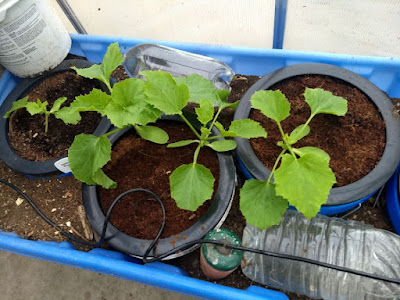Without enough gardens, it can be difficult to determine where I can grow my plants. This last year, I had too many varieties for myself to handle in the three gardens that I had. While I did acquire a garden at the community college over the winter, I had no idea how to manage a 20x20’ plot consisting primarily of weeds. After looking at what a farmer would be willing to grow and what I wanted to make a priority for my main gardens, I decided to grow two varieties that I had low seed stock with and two new varieties that I had recently acquired seed of. The two established varieties were the Dark Armenian (Tortarello Barese) and the Scopattizo Barese while the two new varieties were the Tar Kakdi (a snakemelon variety from India) and the Palastinian Faqous.
I decided that I needed at least six plants, so I would have each host care for six buckets of one cucumber-melon variety. Then I went about trying to find people who would be comfortable with me growing plants in their yards. The owner of the chicken garden was willing to host a set of buckets, two friends at church were also willing. Finally, I found one woman from the community college who was willing to host a set of buckets. With the hosts determined, I then went about starting transplants and transplanting each soil block into the buckets. The most important part of this was labeling. At one point, I had to pull out some transplants because I accidentally forgot to label which variety was which and I accidentally put some of the transplants together.
So here is how each variety did:
The Faqous was my most important variety. For this variety, I found an expensive organic soil business that would deliver a whole yard of high quality growing mix. I had this mix delivered to my friend’s house, then we used a pallet jack to bring it to the correct place in his yard. Then I transferred the hydroponic baskets into the soil. The plants did very well, but the plants went from fruiting to setting seed so quick that the plants quickly died immediately afterwards. It was great that the plants were so efficient, but how quick the plants produced seed caught me a little off-guard. I thought that the plants might last a little longer.
The Tar Kakdi grew for a little while, but turned out to not be the variety I was looking for. So instead of trying to fight the heat of the summer, I just gathered all the buckets from this friend and came home with them. My hope for this variety was that it would produce very long thin cucumbers. Unfortunately, it produced misshapen cucumbers with some variations in color.
The Dark Armenian was grown out by a friend of mine who manages a nursery in American Canyon. The plants did relatively well, then started to go downhill. I harvested a little bit of good seed from the fruit that we grew on his property.
The Scopattizo Barese were grown on the plot of a friend of mine who, with her husband, does a lot to care for the garden plots at the community college where my new garden plot was. She had some extra space, so transferred some of the struggling hydroponic baskets into the ground, where they did much better than in the buckets. They produced well, though I have yet to harvest all the seeds from these plants.
Lessons Learned: Growing plants in buckets using hydroponic baskets is definitely a short-term solution. I am lucky to get one or two fruit if I am growing in full sun in Northern California. That being said, starting in hydroponic baskets and transferring the plants into a garden or larger plots works relatively well. I will likely see if I can utilize the connections that I have made and grow in one larger container in each garden I am able to next year.





























